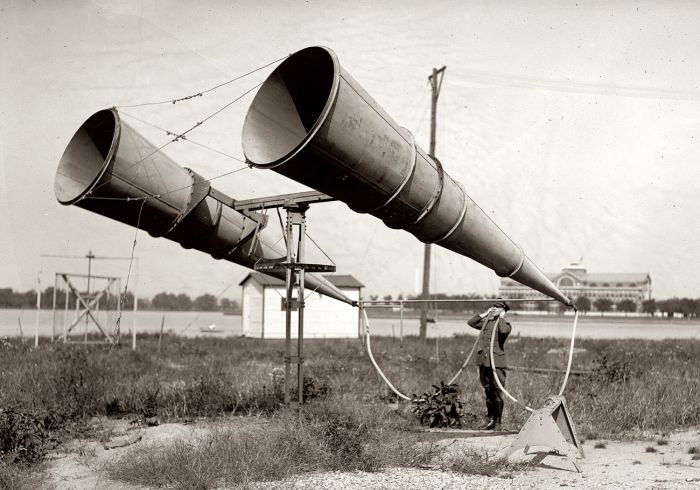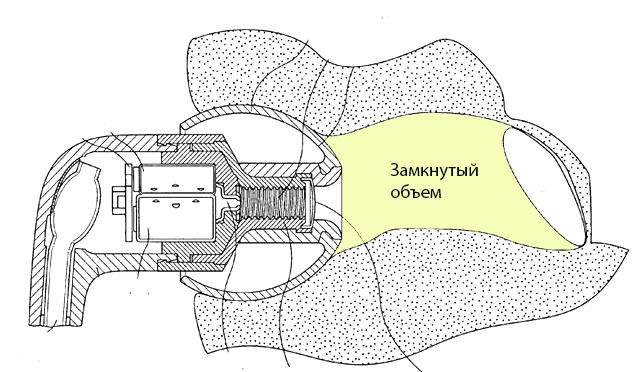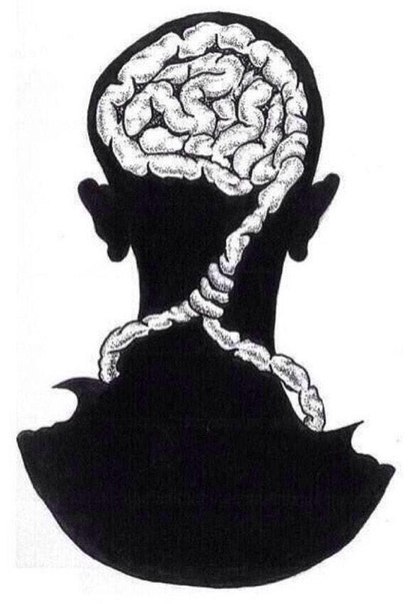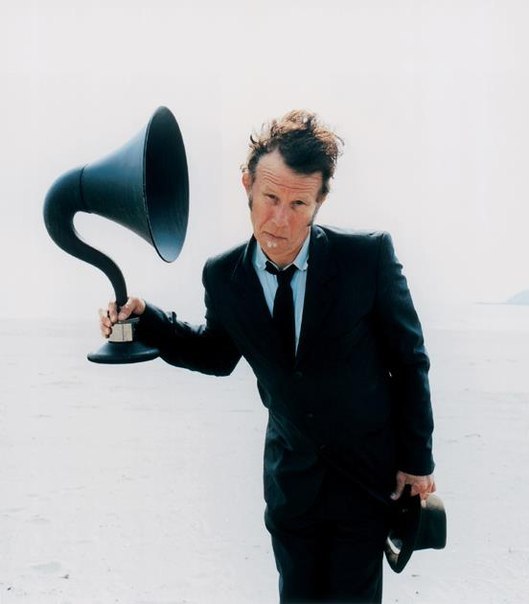Fiction and facts about the dangers of headphones: how to avoid auditory "impotence"
Readers' comments to our articles on headphones demonstrate a genuine interest in the issue of ear damage to headphones for the listener's health. As answers to some of them, we publish this post. Lovers of brief information and those who do not like smearing information on the “sheet” of the text, I will give a quick answer: no, headphones are not harmful and do not pose a threat - this is just a myth created by speculative articles in the near-medical media. The real threat to themselves is represented by some of the users who ignore the recommendations for operation and sincerely believe that in doing so they will carry them.

Further detail about the problem and its features.
The dry WHO statistics show a non-comic global problem. About 10% of the world's population suffers from hearing impairment or deafness. According to a study conducted by WHO experts, about a third of the deaf and hearing impaired in the United States received these problems as a result of exposure to loud music, industrial noise and equipment sounds. The collection of WHO statistics in Europe shows that 71,000,000 people suffer from some kind of hearing problem.

A few years ago, American researcher Robert Novak from Purdue University stated that American doctors began to diagnose rapid hearing loss in young people at a rate that is usually found only in elderly patients. In some cases, this damage is irreversible and leads to complete deafness. In his study, Novak directly linked this tendency to the constant use of headphones, which reproduce music at a volume that is dangerous to health. The described study was the cause of numerous speculations in the media.
')
Otolaryngologists and pathophysiologists have found that regular exposure to sound (no matter music or noise) with a sound pressure of more than 100 dB, leads to damage to the hair cells of the basilar membrane, which in most cases leads to irreversible hearing impairment. The basilar membrane is located in the cochlea and is an integral part of the auditory analyzer, since it is through this element that the sound waves of various amplitudes and frequencies are converted into nerve impulses, which are transmitted to the brain via the cochlear nerve. As a result of damage to the cells (hairs) in one or another part of the membrane, problems arise with the perception of certain frequencies.

It is known that comfortable for listening to music in headphones , for most people (without hearing loss and hyperesthesia) is sound pressure in the range from 70 to 90 dB. When developing headphones, most manufacturers rely on this data, while making a certain margin on the power of sound emitters. It is also important to take into account the impedance of the headphones, as sometimes a low impedance of the headphones, compared with the amplifier of a player or phone, can give a high volume.

At the same time, people tend to increase the volume to the limit values, this is especially common when traveling on the subway. As a result of a hot desire to abstract from the noise of a metro user, conceived, exceeds the permissible barrier of 100 dB, since the noise level in the metro is higher and ranges from 95 to 105 - 110 dB.

Thus, in order to listen to music in the subway or other place with a high level of noise, we have to increase the volume above the dangerous limit for hearing. Short-term and non-regular increase in volume does not pose serious problems, since the compensatory capabilities of the middle and inner ears reduce the likelihood of irreversible changes. Constant use of headphones in this mode leads to damage to the basilar hair cells, which exclude the possibility of the membrane returning to its normal state.
Based on a number of studies conducted in the last 10 years, journalists have created a number of speculative publications about the dangers of headphones and their individual types, in which unreasonable conclusions are drawn, and sometimes, ludicrous recommendations are given to users of gadgets. Next, I will try to separate the wheat from the chaff and give some useful tips on this.
Reality: The birth of this myth is connected with the research of several American scientists, in particular, the already mentioned Novak. Novak noticed that damage to the hair cells of the basilar membrane, usually characteristic of people older than 35 - 40 years, becomes characteristic of some young people using headphones. However, the media hastened to inflate the sensation that young people stall from the headphones, which is not entirely true and is a distortion of the facts.

As I already wrote above, the problems indicated by the researchers are characteristic only in cases when the sound pressure exceeds the limit of 100 dB, while such an excess occurs continuously, over a long time. This situation is typical for people who use headphones without active noise cancellation and are trying to drown out ambient noise using power reserves. In this case, do it all the time.
In fact, it is not the headphones that are harmful, but the habit of raising the volume level until the moment when the surrounding loud (more than 90-100 dB) sounds can not be heard. Over time, the perception adapts to such a volume level, and listening at a lower volume becomes uncomfortable, which further aggravates the situation.
Reality: A study by Dr. Brian Flaigor at Harvard Medical School, published in the December 2004 issue of Ear and Hearing, found that the level of sound pressure acting on an ear depends on the type of headphones . So, the smaller the earpiece, the higher the sound pressure level at equal given volume values. The scientist found that plug-in and in-ear headphones increase the sound pressure level, on average, by 9 dB, compared to overhead and full-size ones.

In fact, the study of Flaigor demonstrates only that when listening to music through the "earbuds" and "plugs", for the prevention of hearing damage it is worth reducing the volume, given that their sound pressure is higher.
Researchers from the National Australian Acoustic Laboratory in Sydney concluded that the in-ear headphones, allowing you to hear the surrounding sounds, provoke the user to turn up the volume. At the same time, this trend was not observed with in-ear headphones.
Reality: As in previous speculations, the conclusion is far-fetched. For the development of infection in the external auditory canal, such conditions as the presence of bacteria, fungal spores, etc. are necessary. (there are plenty of them everywhere, and the material of the headphones is not a nutrient medium, as is the material of ear cushions), the presence of entrance gates for infection, for example, trauma, microtrauma, etc., reduced immunity, impaired blood circulation.

Under the described combination of conditions, headphones are not any significant risk factor affecting the development of infection. The infection will quietly develop without them, it is enough to have an immunodeficiency state and touch the ear.
Reality: Headphones affect our psyche and intelligence no more than any other source of sound in our environment. At the same time, the music we listen to may, to one degree or another, affect the psycho-emotional state, which has been known for a long time and does not require proof.

Reality: listening to music requires more sound pressure (70 - 90 dB) than human speech and a natural background noise level for a person (45 - 60 dB).
Prolonged (more than 4 hours a day) daily use of headphones can lead to a noticeable decrease in hearing. I emphasize, maybe, but in this case it very much depends on the individual characteristics of a particular person. Sound engineers, DJs and some musicians, due to the nature of their work, spend quite a long time in headphones (6-8 hours), while there are no studies that representatives of these professions are more likely to suffer from hearing problems.

When used properly, headphones are completely safe and cannot cause hearing loss, inflammation, loss of intelligence or insanity. At the same time, regular use of high volume in order to muffle external loud sounds (metro, jet aircraft, industrial noise) can lead to irreversible hearing impairment.
To protect yourself from hearing damage when using headphones, it is enough to observe the following:

Further detail about the problem and its features.
Alarming statistics
The dry WHO statistics show a non-comic global problem. About 10% of the world's population suffers from hearing impairment or deafness. According to a study conducted by WHO experts, about a third of the deaf and hearing impaired in the United States received these problems as a result of exposure to loud music, industrial noise and equipment sounds. The collection of WHO statistics in Europe shows that 71,000,000 people suffer from some kind of hearing problem.

A few years ago, American researcher Robert Novak from Purdue University stated that American doctors began to diagnose rapid hearing loss in young people at a rate that is usually found only in elderly patients. In some cases, this damage is irreversible and leads to complete deafness. In his study, Novak directly linked this tendency to the constant use of headphones, which reproduce music at a volume that is dangerous to health. The described study was the cause of numerous speculations in the media.
')
The causes of the problem - the mechanism of hearing damage
Otolaryngologists and pathophysiologists have found that regular exposure to sound (no matter music or noise) with a sound pressure of more than 100 dB, leads to damage to the hair cells of the basilar membrane, which in most cases leads to irreversible hearing impairment. The basilar membrane is located in the cochlea and is an integral part of the auditory analyzer, since it is through this element that the sound waves of various amplitudes and frequencies are converted into nerve impulses, which are transmitted to the brain via the cochlear nerve. As a result of damage to the cells (hairs) in one or another part of the membrane, problems arise with the perception of certain frequencies.

It is known that comfortable for listening to music in headphones , for most people (without hearing loss and hyperesthesia) is sound pressure in the range from 70 to 90 dB. When developing headphones, most manufacturers rely on this data, while making a certain margin on the power of sound emitters. It is also important to take into account the impedance of the headphones, as sometimes a low impedance of the headphones, compared with the amplifier of a player or phone, can give a high volume.

At the same time, people tend to increase the volume to the limit values, this is especially common when traveling on the subway. As a result of a hot desire to abstract from the noise of a metro user, conceived, exceeds the permissible barrier of 100 dB, since the noise level in the metro is higher and ranges from 95 to 105 - 110 dB.

Thus, in order to listen to music in the subway or other place with a high level of noise, we have to increase the volume above the dangerous limit for hearing. Short-term and non-regular increase in volume does not pose serious problems, since the compensatory capabilities of the middle and inner ears reduce the likelihood of irreversible changes. Constant use of headphones in this mode leads to damage to the basilar hair cells, which exclude the possibility of the membrane returning to its normal state.
The mythology of the harm of equipment and the reality of human stupidity
Based on a number of studies conducted in the last 10 years, journalists have created a number of speculative publications about the dangers of headphones and their individual types, in which unreasonable conclusions are drawn, and sometimes, ludicrous recommendations are given to users of gadgets. Next, I will try to separate the wheat from the chaff and give some useful tips on this.
Fiction: Listening to music with headphones causes hearing loss and hearing loss.
Reality: The birth of this myth is connected with the research of several American scientists, in particular, the already mentioned Novak. Novak noticed that damage to the hair cells of the basilar membrane, usually characteristic of people older than 35 - 40 years, becomes characteristic of some young people using headphones. However, the media hastened to inflate the sensation that young people stall from the headphones, which is not entirely true and is a distortion of the facts.

As I already wrote above, the problems indicated by the researchers are characteristic only in cases when the sound pressure exceeds the limit of 100 dB, while such an excess occurs continuously, over a long time. This situation is typical for people who use headphones without active noise cancellation and are trying to drown out ambient noise using power reserves. In this case, do it all the time.
In fact, it is not the headphones that are harmful, but the habit of raising the volume level until the moment when the surrounding loud (more than 90-100 dB) sounds can not be heard. Over time, the perception adapts to such a volume level, and listening at a lower volume becomes uncomfortable, which further aggravates the situation.
Fiction: Scientists have proved that intra-channel and in-ear headphones are really dangerous - people stall from them
Reality: A study by Dr. Brian Flaigor at Harvard Medical School, published in the December 2004 issue of Ear and Hearing, found that the level of sound pressure acting on an ear depends on the type of headphones . So, the smaller the earpiece, the higher the sound pressure level at equal given volume values. The scientist found that plug-in and in-ear headphones increase the sound pressure level, on average, by 9 dB, compared to overhead and full-size ones.

In fact, the study of Flaigor demonstrates only that when listening to music through the "earbuds" and "plugs", for the prevention of hearing damage it is worth reducing the volume, given that their sound pressure is higher.
Researchers from the National Australian Acoustic Laboratory in Sydney concluded that the in-ear headphones, allowing you to hear the surrounding sounds, provoke the user to turn up the volume. At the same time, this trend was not observed with in-ear headphones.
Fiction: The use of in-ear headphones is unhygienic, leads to the development of fungal and other lesions of the ear canal
Reality: As in previous speculations, the conclusion is far-fetched. For the development of infection in the external auditory canal, such conditions as the presence of bacteria, fungal spores, etc. are necessary. (there are plenty of them everywhere, and the material of the headphones is not a nutrient medium, as is the material of ear cushions), the presence of entrance gates for infection, for example, trauma, microtrauma, etc., reduced immunity, impaired blood circulation.

Under the described combination of conditions, headphones are not any significant risk factor affecting the development of infection. The infection will quietly develop without them, it is enough to have an immunodeficiency state and touch the ear.
Fiction: Regular use of headphones drives you crazy and leads to dementia (acquired loss of intelligence)
Reality: Headphones affect our psyche and intelligence no more than any other source of sound in our environment. At the same time, the music we listen to may, to one degree or another, affect the psycho-emotional state, which has been known for a long time and does not require proof.

Fiction: Daily use of headphones leads to deafness and hearing loss
Reality: listening to music requires more sound pressure (70 - 90 dB) than human speech and a natural background noise level for a person (45 - 60 dB).
Prolonged (more than 4 hours a day) daily use of headphones can lead to a noticeable decrease in hearing. I emphasize, maybe, but in this case it very much depends on the individual characteristics of a particular person. Sound engineers, DJs and some musicians, due to the nature of their work, spend quite a long time in headphones (6-8 hours), while there are no studies that representatives of these professions are more likely to suffer from hearing problems.

Conclusions and recommendations
When used properly, headphones are completely safe and cannot cause hearing loss, inflammation, loss of intelligence or insanity. At the same time, regular use of high volume in order to muffle external loud sounds (metro, jet aircraft, industrial noise) can lead to irreversible hearing impairment.
To protect yourself from hearing damage when using headphones, it is enough to observe the following:
- Do not use headphones in the subway and other places with the same noise level;
- Do not increase the volume above 70-80% (different systems have different amplification options, you can say a few words, if you hear your voice, the volume level is acceptable);
- Do not listen to music with headphones for more than 4 hours a day;
- Do not fall asleep with headphones that play music;
- For noisy places and subways, try to use headphones with active noise cancellation system.
Source: https://habr.com/ru/post/399749/
All Articles